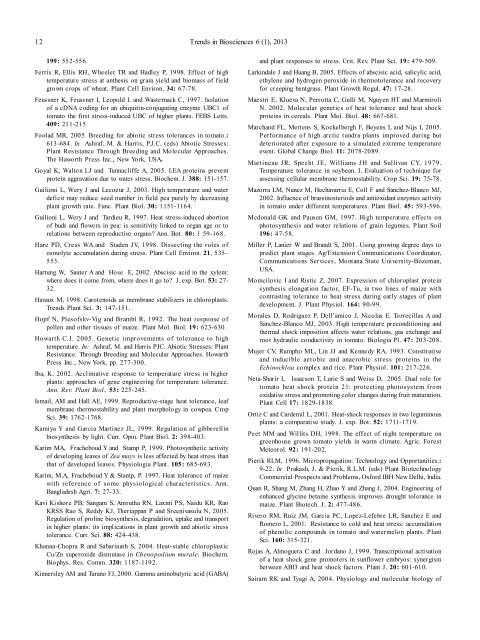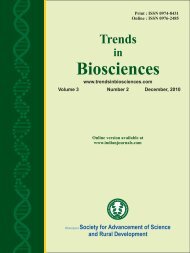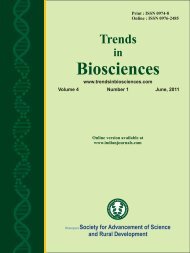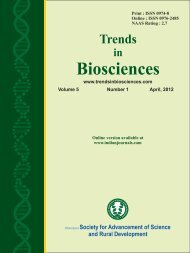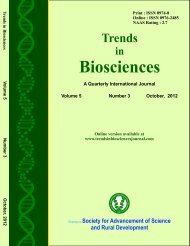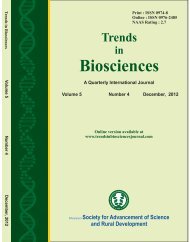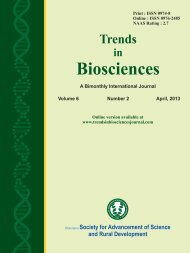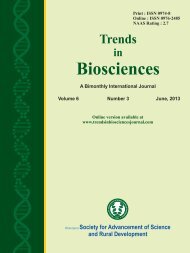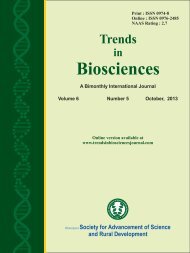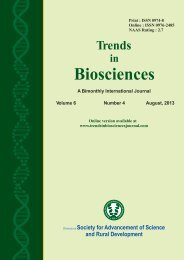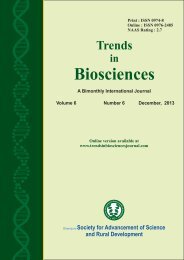TRENDS IN BIOSCIENCES 6-1, 2013 EDITION
CALL FOR RESEARCH PAPERS
CALL FOR RESEARCH PAPERS
Create successful ePaper yourself
Turn your PDF publications into a flip-book with our unique Google optimized e-Paper software.
12 Trends in Biosciences 6 (1), <strong>2013</strong><br />
199: 552-556.<br />
Ferris R, Ellis RH, Wheeler TR and Hadley P, 1998. Effect of high<br />
temperature stress at anthesis on grain yield and biomass of field<br />
grown crops of wheat. Plant Cell Environ. 34: 67-78.<br />
Feussner K, Feussner I, Leopold I. and Wasternack C, 1997. Isolation<br />
of a cDNA coding for an ubiquitin-conjugating enzyme UBC1 of<br />
tomato the first stress-induced UBC of higher plants. FEBS Letts.<br />
409: 211-215.<br />
Foolad MR, 2005. Breeding for abiotic stress tolerances in tomato.:<br />
613-684. In Ashraf, M. & Harris, P.J.C. (eds) Abiotic Stresses:<br />
Plant Resistance Through Breeding and Molecular Approaches.<br />
The Haworth Press Inc., New York, USA.<br />
Goyal K, Walton LJ and Tunnacliffe A, 2005. LEA proteins prevent<br />
protein aggravation due to water stress. Biochem. J. 388: 151-157.<br />
Guilioni L, Wery J and Lecoeur J, 2003. High temperature and water<br />
deficit may reduce seed number in field pea purely by decreasing<br />
plant growth rate. Func. Plant Biol. 30: 1151-1164.<br />
Guilioni L, Wery J and Tardieu R, 1997. Heat stress-induced abortion<br />
of buds and flowers in pea: is sensitivity linked to organ age or to<br />
relations between reproductive organs? Ann. Bot. 80: 1 59-168.<br />
Hare PD, Cress WA and Staden JV, 1998. Dissecting the roles of<br />
osmolyte accumulation during stress. Plant Cell Environ. 21, 535–<br />
553.<br />
Hartung W, Sauter A and Hose E, 2002. Abscisic acid in the xylem:<br />
where does it come from, where does it go to? J. exp. Bot. 53: 27-<br />
32.<br />
Havaux M, 1998. Carotenoids as membrane stabilizers in chloroplasts.<br />
Trends Plant Sci. 3: 147-151.<br />
Hopf N, Plesofskv-Vig and Brambl R, 1992. The heat response of<br />
pollen and other tissues of maize. Plant Mol. Biol. 19: 623-630.<br />
Howarth C.J. 2005. Genetic improvements of tolerance to high<br />
temperature. In: Ashraf, M. and Harris PJC. Abiotic Stresses: Plant<br />
Resistance. Through Breeding and Molecular Approaches. Howarth<br />
Press Inc., New York, pp. 277-300.<br />
Iba, K. 2002. Acclimative response to temperature stress in higher<br />
plants: approaches of gene engineering for temperature tolerance.<br />
Ann. Rev. Plant Biol., 53: 225-245.<br />
Ismail, AM and Hall AE, 1999. Reproductive-stage heat tolerance, leaf<br />
membrane thermostability and plant morphology in cowpea. Crop<br />
Sci. 39: 1762-1768.<br />
Kamiya Y and Garcia Martinez JL, 1999. Regulation of gibberellin<br />
biosynthesis by light. Curr. Opin. Plant Biol. 2: 398-403.<br />
Karim MA, Fracheboud Y and Stamp P, 1999. Photosynthetic activity<br />
of developing leaves of Zea mays is less affected by heat stress than<br />
that of developed leaves. Physiologia Plant. 105: 685-693.<br />
Karim, M.A, Fracheboud Y & Stamp, P. 1997. Heat tolerance of maize<br />
with reference of some physiological characteristics. Ann.<br />
Bangladesh Agri. 7: 27-33.<br />
Kavi Kishore PB, Sangam S, Amrutha RN, Laxmi PS, Naidu KR, Rao<br />
KRSS Rao S, Reddy KJ, Theriappan P and Sreenivasulu N, 2005.<br />
Regulation of proline biosynthesis, degradation, uptake and transport<br />
in higher plants: its implications in plant growth and abiotic stress<br />
tolerance. Curr. Sci. 88: 424-438.<br />
Khanna-Chopra R and Sabarinath S, 2004. Heat-stable chloroplastic<br />
Cu/Zn superoxide dismutase in Chenopodium murale. Biochem.<br />
Biophys. Res. Comm. 320: 1187-1192.<br />
Kinnersley AM and Turano FJ, 2000. Gamma aminobutyric acid (GABA)<br />
and plant responses to stress. Crit. Rev. Plant Sci. 19: 479-509.<br />
Larkindale J and Huang B, 2005. Effects of abscisic acid, salicylic acid,<br />
ethylene and hydrogen peroxide in thermotolerance and recovery<br />
for creeping bentgrass. Plant Growth Regul. 47: 17-28.<br />
Maestri E, Klueva N, Perrotta C, Gulli M, Nguyen HT and Marmiroli<br />
N. 2002. Molecular genetics of heat tolerance and heat shock<br />
proteins in cereals. Plant Mol. Biol. 48: 667-681.<br />
Marchand FL, Mertens S, Kockelbergh F, Beyens L and Nijs I, 2005.<br />
Performance of high arctic tundra plants improved during but<br />
deteriorated after exposure to a simulated extreme temperature<br />
event. Global Change Biol. 11: 2078-2089.<br />
Martineau JR, Specht JE, Williams JH and Sullivan CY, 1979.<br />
Temperature tolerance in soybean. I. Evaluation of technique for<br />
assessing cellular membrane thermostability. Crop Sci. 19: 75-78.<br />
Mazorra LM, Nunez M, Hechavarria E, Coll F and Sanchez-Blanco MJ,<br />
2002. Influence of brassinosteriods and antioxidant enzymes activity<br />
in tomato under different temperatures. Plant Biol. 45: 593-596.<br />
Mcdonald GK and Pausen GM, 1997. High temperature effects on<br />
photosynthesis and water relations of grain legumes. Plant Soil<br />
196: 47-58.<br />
Miller P, Lanier W and Brandt S, 2001. Using growing degree days to<br />
predict plant stages. Ag/Extension Communications Coordinator,<br />
Communications Services, Montana State University-Bozeman,<br />
USA.<br />
Momcilovic I and Ristic Z, 2007. Expression of chloroplast protein<br />
synthesis elongation factor, EF-Tu, in two lines of maize with<br />
contrasting tolerance to heat stress during early stages of plant<br />
development. J. Plant Physiol. 164: 90-99.<br />
Morales D, Rodriguez P, Dell’amico J, Nicolas E, Torrecillas A and<br />
Sanchez-Blanco MJ, 2003. High temperature preconditioning and<br />
thermal shock imposition affects water relations, gas exchange and<br />
root hydraulic conductivity in tomato. Biologia Pl. 47: 203-208.<br />
Mujer CV, Rumpho ML, Lin JJ and Kennedy RA, 1993. Constitutive<br />
and inducible aerobic and anaerobic stress proteins in the<br />
Echinochloa complex and rice. Plant Physiol. 101: 217-226.<br />
Neta-Sharir I, Isaacson T, Lurie S and Weiss D, 2005. Dual role for<br />
tomato heat shock protein 21: protecting photosystem from<br />
oxidative stress and promoting color changes during fruit maturation.<br />
Plant Cell 17: 1829-1838.<br />
Ortiz C and Cardemil L, 2001. Heat-shock responses in two leguminous<br />
plants: a comparative study. J. exp. Bot. 52: 1711-1719.<br />
Peet MM and Willits DH, 1998. The effect of night temperature on<br />
greenhouse grown tomato yields in warm climate. Agric. Forest<br />
Meteorol. 92: 191-202.<br />
Pierik RLM, 1996. Micropropagation: Technology and Opportunities.:<br />
9-22. In Prakash, J. & Pierik, R.L.M. (eds) Plant Biotechnology<br />
Commercial Prospects and Problems, Oxford IBH New Delhi, India.<br />
Quan R, Shang M, Zhang H, Zhao Y and Zhang J, 2004. Engineering of<br />
enhanced glycine betaine synthesis improves drought tolerance in<br />
maize. Plant Biotech. J. 2: 477-486.<br />
Rivero RM, Ruiz JM, Garcia PC, Lopez-Lefebre LR, Sanchez E and<br />
Romero L, 2001. Resistance to cold and heat stress: accumulation<br />
of phenolic compounds in tomato and watermelon plants. Plant<br />
Sci. 160: 315-321.<br />
Rojas A, Almoguera C and Jordano J, 1999. Transcriptional activation<br />
of a heat shock gene promoters in sunflower embryos: synergism<br />
between ABI3 and heat shock factors. Plant J. 20: 601-610.<br />
Sairam RK and Tyagi A, 2004. Physiology and molecular biology of


